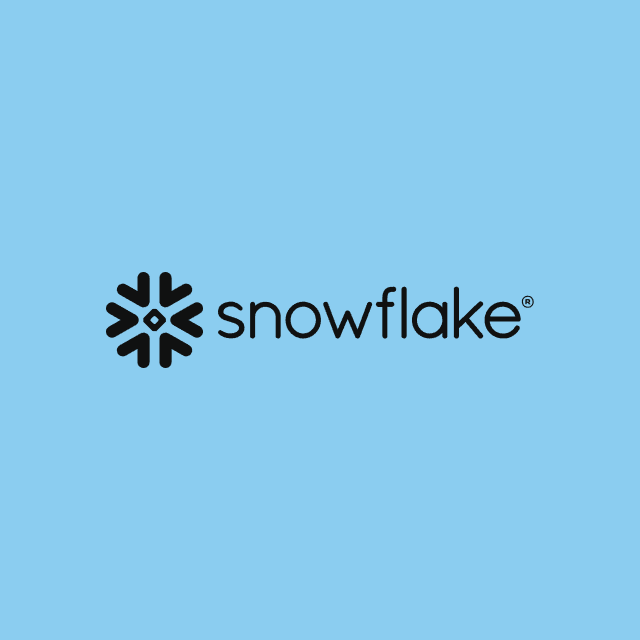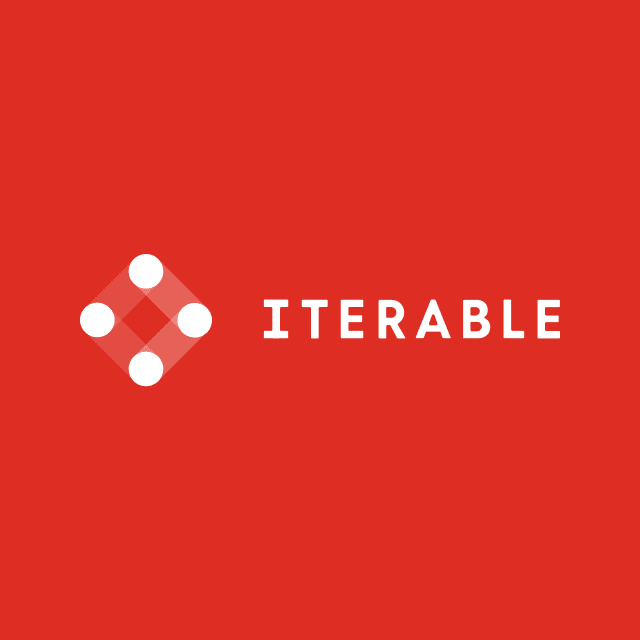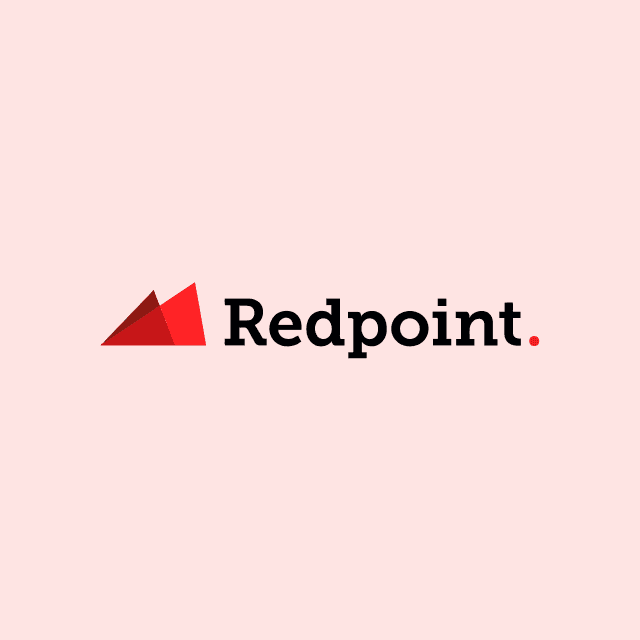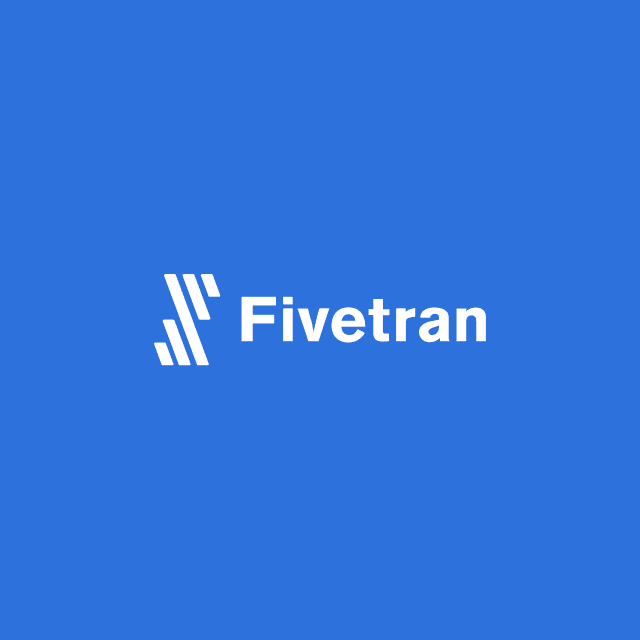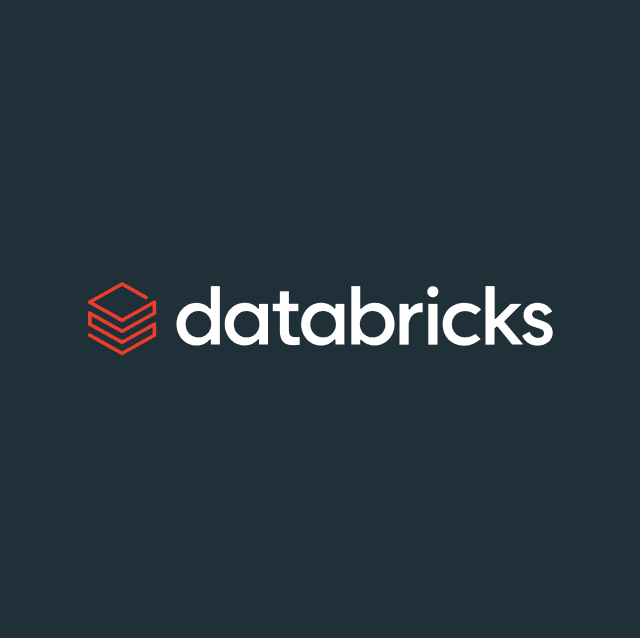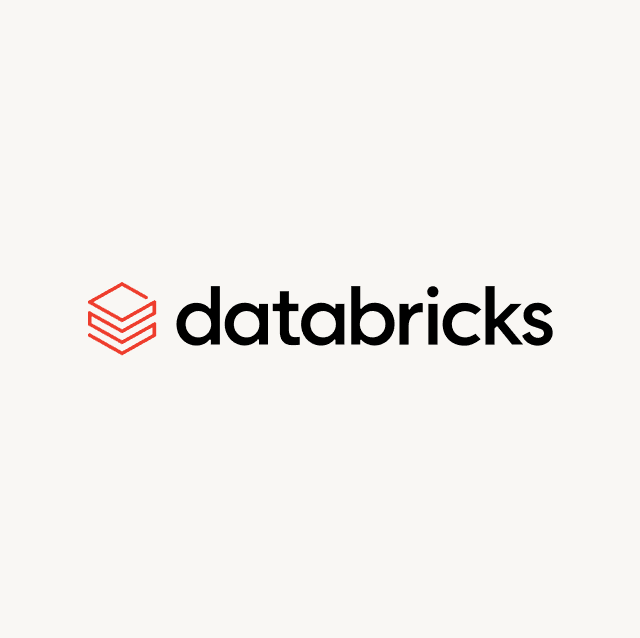As privacy regulations tighten and traditional tracking methods become less reliable, marketers are increasingly challenged to measure results and confidently optimize their campaigns. Browser-based pixels are often blocked by ad blockers, restricted by operating systems, or disrupted by network conditions, causing lost conversions and incomplete performance data.
The Pinterest Conversions API (CAPI) addresses these challenges by allowing advertisers to send conversion data directly from their servers to Pinterest. This server-side integration improves data accuracy, increases signal reliability, and gives you complete control over how and when conversion events are shared.
In this guide, you'll learn how to set up the Pinterest Conversions API using your first-party customer and event data. By enabling server-side conversion tracking, you’ll be able to improve attribution, optimize campaigns with richer insights, and maximize return on ad spend (ROAS), even as the digital advertising landscape becomes increasingly privacy-first.
How to set up Pinterest conversion API?
1. Connect to your data source
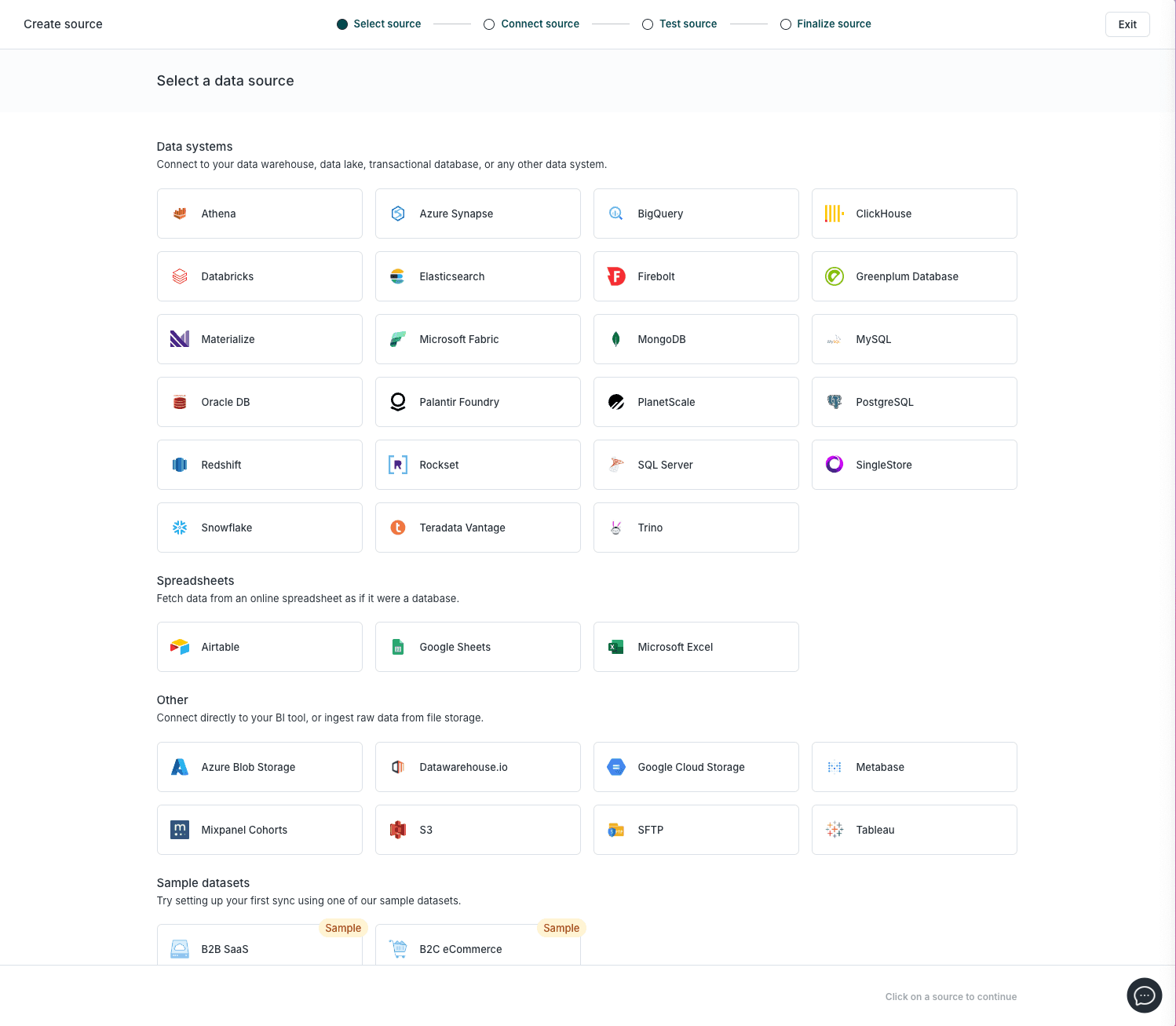
Start by creating a Hightouch account. Once you're logged in:
- Navigate to the Integrations, then Sources.
- Select the data source that contains your event and customer data. This could be a data warehouse like Snowflake, BigQuery, Redshift, or a database like Postgres or MySQL.
- Enter your configuration details, such as credentials and hostnames, to authenticate your data source.
Hightouch will validate your connection and give you access to the schema for building your data model.
2. Define your data model
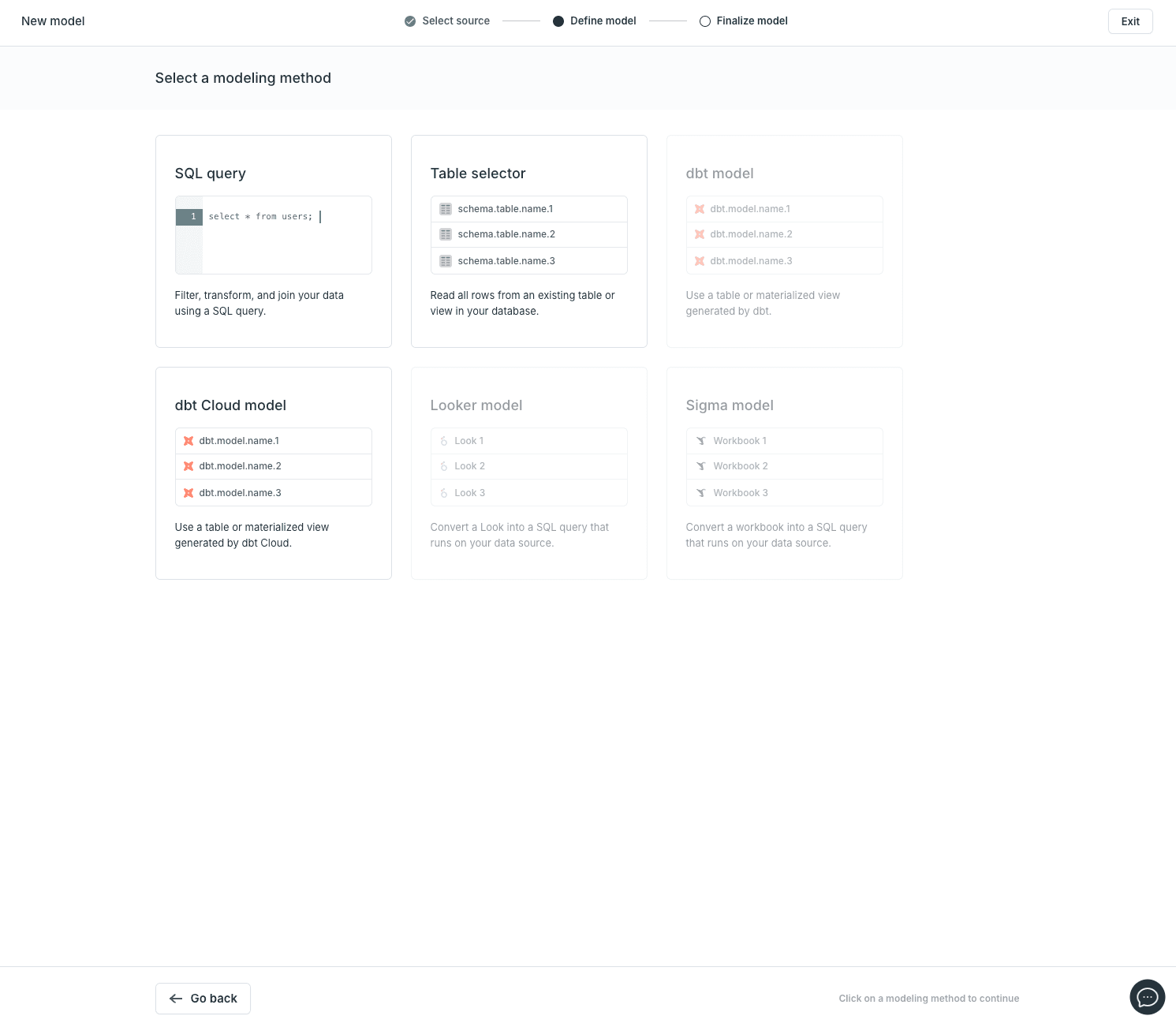
Next, define the event data you want to send to Pinterest. You can do this in three ways:
- SQL Editor: Write custom SQL to join and transform data for precise control.
- Table Selector: Choose pre-built tables and columns directly without needing SQL.
- Visual Audience Builder: Use a no-code interface to filter and segment your data based on behavior, properties, or timestamps.
This data model acts as the source of truth for what gets sent to Pinterest. Typical fields include user identifiers (email, phone), event names (purchase, signup), and metadata (value, currency, timestamp).
3. Create a Pinterest conversion destination
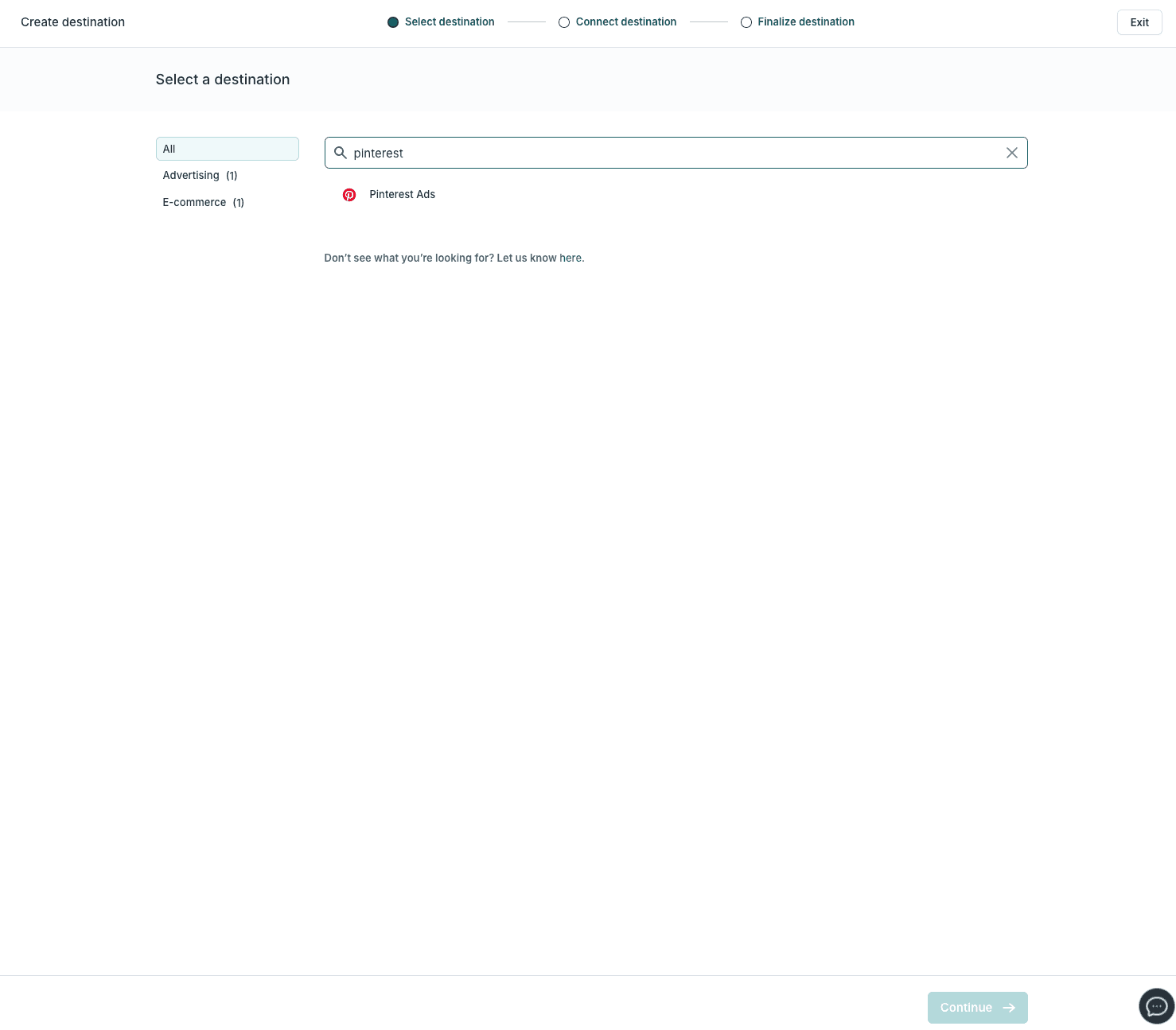
Now it’s time to connect Hightouch to Pinterest:
- Go to the Integrations, then Destinations.
- Click Add Destination and select Pinterest.
- Log in to Pinterest to authorize the connection.
4. Send conversions to Pinterest
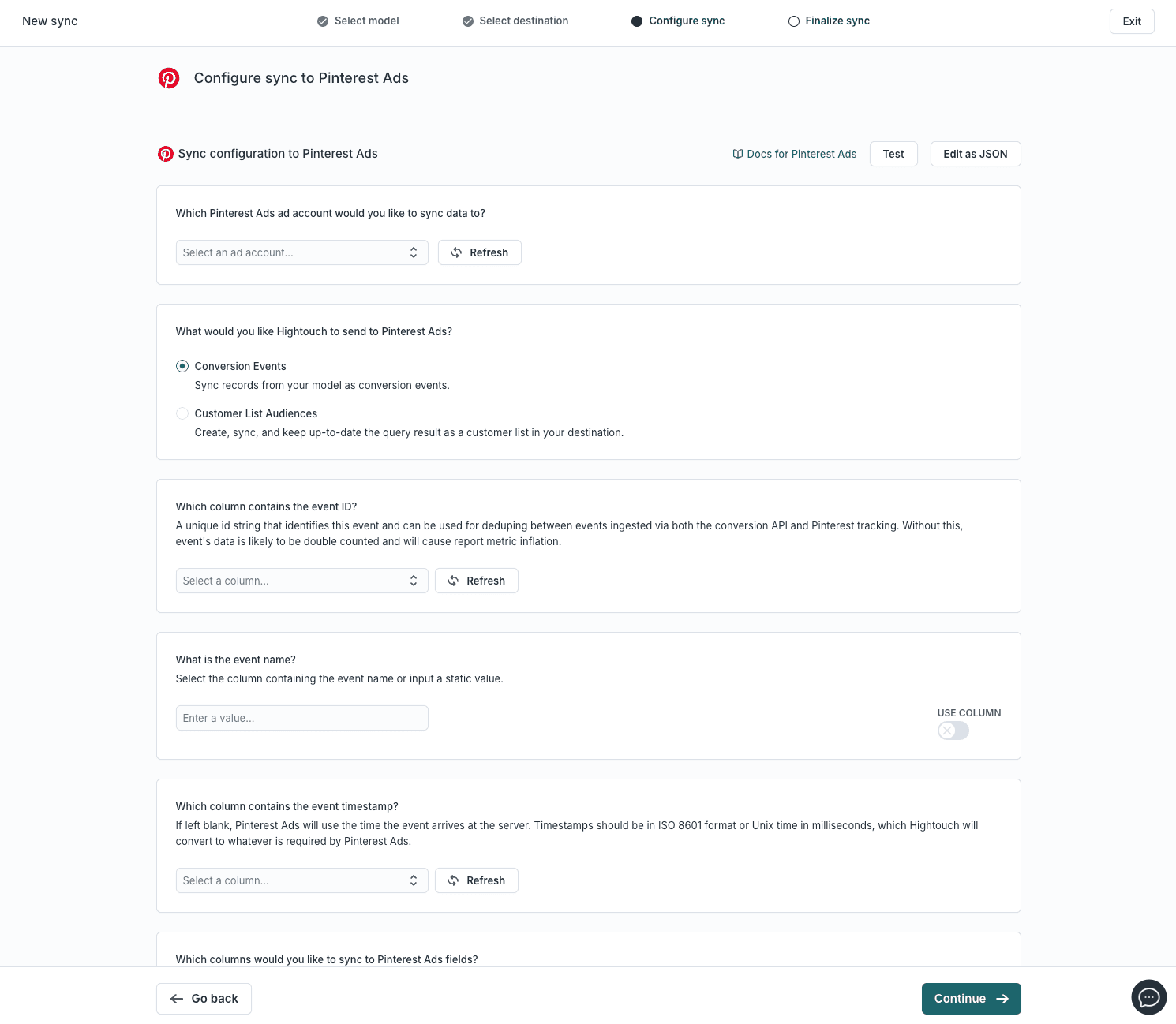
Finally, you’ll configure your sync:
- Got to Activation, then Syncs.
- Click Add sync.
- Choose the model you created and your Pinterest destination.
- Map the data fields in your model to Pinterest’s expected parameters
- Run your sync.
What is the Pinterest conversions API?
The Pinterest Conversions API (CAPI) is a server-side solution that allows advertisers to send conversion data directly from their backend systems to Pinterest. It is a powerful alternative to traditional web pixels and JavaScript-based tracking, which operate in the user's browser and are increasingly disrupted by privacy features and ad blockers.
Unlike browser-based tracking, the Pinterest Conversions API enables you to leverage your first-party data, from data warehouses, CRMs, CDPs, or backend servers, to deliver conversion events such as purchases, sign-ups, or form submissions. This direct server-to-server connection ensures that your most crucial marketing signals are delivered reliably, even in environments where browser tracking fails.
By adopting the Pinterest Conversions API, you gain complete control over the data you send, including which events are tracked, what user identifiers (such as email or IP address), and how values like revenue or customer lifetime value are attached to each event. This allows for deeper customization, better compliance with data privacy regulations, and more aligned optimization toward your specific business outcomes.
Moreover, because CAPI operates outside of the browser, it is resilient to common disruptions such as:
- Ad blockers and cookie restrictions
- iOS limitations like App Tracking Transparency (ATT)
- Safari’s Intelligent Tracking Prevention (ITP)
- Poor network connections or JavaScript failures
This makes Pinterest CAPI a foundational tool for advertisers who want to maximize attribution, improve optimization accuracy, and future-proof their campaigns against an evolving privacy landscape.
Whether you’re focused on e-commerce purchases, lead generation, or offline conversions like phone calls and in-store transactions, the Pinterest Conversions API gives you the flexibility and reliability to capture, measure, and act on the data that drives real business impact.
Benefits of using pinterest conversion API
The Pinterest Conversions API (CAPI) enables advertisers to send conversion events directly from their servers to Pinterest, bypassing the limitations of browser-based tracking. This server-side approach delivers stronger signal quality, more reliable attribution, and smarter optimization by giving Pinterest better visibility into user actions. Whether your goal is to increase conversions, improve efficiency, or prepare for a privacy-first future, Pinterest CAPI provides the infrastructure to support high-performing campaigns.
- Lower Your Cost Per Result (CPR) by up to 13%: When conversions are underreported due to tracking limitations, Pinterest’s algorithm has fewer signals to optimize against, which can result in inefficient bidding and increased costs. Using the Conversions API, advertisers provide Pinterest with a more complete picture of user activity, allowing the platform to allocate budget more effectively. This improved signal quality translates into sharper targeting and up to 13% lower CPR, letting advertisers stretch their budgets further and reach more high-value users.
- Increase Attributed Purchase Events by up to 19%: Ad blockers, cookie restrictions, and iOS privacy controls can cause web pixels to miss important conversion events, leading to undercounting. The Pinterest CAPI addresses this by sending events directly from your backend, ensuring fewer dropped signals and up to 19% more purchase events attributed to your campaigns. More complete attribution improves reporting accuracy and enhances Pinterest’s optimization engine, which relies on event feedback to drive smarter campaign decisions.
- Boost Your Return on Ad Spend (ROAS): With higher-quality data and more complete event capture, Pinterest can better understand which users are most likely to convert, and at what value. This allows its delivery algorithm to make smarter, data-driven bidding decisions, prioritizing actions with greater revenue potential. As a result, advertisers who use Pinterest CAPI typically see improved efficiency and stronger ROAS, particularly for performance-focused goals like purchases, subscriptions, and lead generation.
- Unlock Better Measurement and Attribution: The Conversions API gives advertisers complete control over the data sent to Pinterest, enabling more profound insights and granular performance analysis. You can enrich conversion events with customer attributes, order values, funnel stage data, or custom fields, unlocking a more detailed view of how your marketing efforts drive tangible outcomes. This flexibility allows for improved attribution modeling, better campaign tuning, and alignment with internal KPIs across marketing and sales teams.
- Future-Proof Campaigns Against Privacy Changes: As browser vendors and mobile operating systems continue to roll out stricter privacy features, such as Safari’s Intelligent Tracking Prevention (ITP) and Apple’s App Tracking Transparency (ATT), traditional client-side tracking is becoming increasingly unreliable. The Pinterest Conversions API lets advertisers maintain robust monitoring and measurement through first-party server-side data, making it more resilient to privacy restrictions. By adopting CAPI now, you can future-proof your campaigns and ensure you continue to deliver strong performance in an evolving privacy landscape.
What's the difference between a pixel and the Pinterest conversions API?
Traditional tracking pixels operate on the client side, meaning they run directly in the user’s browser or mobile app. When a user completes an action, like making a purchase or signing up, the pixel fires and automatically sends that data to Pinterest. While easy to implement, pixels rely heavily on cookies and browser scripts, making them increasingly unreliable in a privacy-first world.
As privacy policies, browser restrictions, and ad blockers become more aggressive, client-side pixels often cannot fire or transmit events accurately. This leads to signal loss, underreported conversions, and wasted ad spend.
The Pinterest Conversions API (CAPI) solves this by enabling advertisers to send events directly from their server to Pinterest. This server-side approach gives you complete control over the event data you share, supports online and offline conversions, and ensures consistent signal delivery, even in environments where pixels are blocked or limited.
Although server-side implementation may require more initial setup, it delivers greater data reliability, more accurate attribution, and stronger campaign performance in the long run.
Here’s a quick comparison between traditional web pixels and the Pinterest Conversions API:
| Feature | Traditional Pixel | Pinterest Conversions API |
|---|---|---|
| Tracking Method | Track events using a web script or mobile SDK | Track and store events in your internal systems, such as a CRM, CDP, or data warehouse |
| Delivery Method | Events are sent client-side via browser or app-based scripts | Events are sent server-side via API directly from your backend to Pinterest |
| Reliability | Frequently blocked by ad blockers, cookies, or browser restrictions | Not affected by browser or OS restrictions; ensures more consistent and complete delivery |
| Supported Properties | Typically only supports website interactions | Supports both online and offline conversions, including CRM and in-store purchase events |
| Privacy & Compliance | Limited control over what user data is shared | Full control over the data shared, allowing better compliance with user consent preferences |
| Benefits | Easy to set up but limited in scope and reliability | Improved attribution, stronger optimization signals, and better spend efficiency |
As the advertising ecosystem continues to evolve, switching from a browser-based pixel to a server-based API is no longer just a technical improvement; it’s a strategic necessity for future-proofing your campaigns on Pinterest.
Why are companies switching to conversion APIs?
Client-side tracking is becoming increasingly unreliable due to modern privacy protections and user behavior. Technologies like Intelligent Tracking Prevention (ITP) in Safari, App Tracking Transparency (ATT) from Apple, and widespread use of ad blockers are severely limiting the accuracy and coverage of traditional browser-based pixels. This results in underreported conversions, reduced match rates, and lower campaign efficiency.
To solve this, Pinterest and nearly every central ad platform are introducing a Conversions API that allows advertisers to send events directly from their servers. This server-side integration bypasses browser limitations, enhances data reliability, and gives advertisers more control over how conversion data is collected, structured, and delivered. As a result, advertisers can continue to track, measure, and optimize their campaigns with greater accuracy, even as the digital ecosystem becomes more privacy-restricted.
Below are key reasons why advertisers are adopting the Pinterest Conversions API:
- Capture Offline Conversions: The Pinterest Conversions API allows advertisers to track and upload offline events that pixels can’t capture, like in-store purchases, phone sales, or CRM pipeline updates. These conversions are essential for both B2C and B2B businesses and ensure that Pinterest’s optimization engine can account for the full customer journey, both online and offline.
- Improve Match Rates with First-Party Data: The Conversions API improves event match quality (EMQ) by enriching events with first-party identifiers like email, phone number, IP address, or user agent. This enables more accurate attribution and helps Pinterest deliver smarter campaign optimizations, even when browser data is restricted or blocked.
- Unlock Value-Based Bidding: Advertisers can assign monetary values to conversion events, allowing Pinterest to prioritize high-value outcomes over low-value ones. This unlocks value-based bidding, enabling the platform to allocate budget toward users and actions that drive the most business impact, improving overall return on ad spend (ROAS).
Pinterest conversion API use cases
Advertisers can tailor their setup and bidding strategy with the Pinterest Conversions API to align with specific business outcomes. Whether you're focused on increasing conversion volume, growing total revenue, or maximizing profitability, Pinterest gives you the flexibility to send the correct data to optimize accordingly.
Optimize for conversion volume
To optimize for conversion volume, configure your setup to send conversion events without assigning revenue or monetary values. These events typically represent actions like purchases, sign-ups, or form submissions, and the goal is to increase quantity rather than value. Use Pinterest’s Maximize Conversions or Target CPA bidding strategies to drive the highest number of conversions at the lowest possible cost per action.
| Industry | Optimization Goal |
|---|---|
| Retail & E-commerce | Maximize the volume of purchase events on the website, in-app, and in-store |
| Media & Entertainment | Maximize the volume of subscription sign-ups |
| Financial Services | Maximize the volume of loan applications submitted |
| B2B SaaS | Maximize the volume of demo requests or product signups |
| Travel | Maximize the number of flights or rooms booked |
| Healthcare | Maximize the volume of health service signups |
| Education | Maximize the volume of enrollments for a course or event |
Optimize for conversion value
To optimize for conversion value, send the gross revenue associated with each conversion event, such as the total order or subscription amount. Pinterest’s Maximize Conversion Value or Target ROAS bidding strategies will aim to increase the total revenue generated from your ads rather than just the number of conversions.
| Industry | Optimization Goal |
|---|---|
| Retail & E-commerce | Maximize the gross revenue value of each purchase |
| Media & Entertainment | Maximize the gross revenue from the first subscription payment |
| Financial Services | Maximize the potential value of loan applications submitted |
| B2B SaaS | Maximize the volume of qualified demo requests or product signups |
| Travel | Maximize the gross revenue value of flights or rooms booked |
| Healthcare | Maximize the gross revenue value of health service signups |
| Education | Maximize the gross revenue value of enrollments for a course or event signup |
Optimize for financial outcome
Calculate and send the predicted financial value of each conversion to optimize for financial outcomes such as profitability or customer lifetime value (LTV). This could include estimated profit margins and net revenue after the cost of goods sold (COGS) or modeled LTV. Use Pinterest’s Maximize Value or Target ROI bidding strategies to align ad spend with true business performance.
| Industry | Optimization Goal |
|---|---|
| Retail & E-commerce | Maximize the estimated profit of purchases by subtracting COGS, taxes, and fees |
| Media & Entertainment | Maximize the estimated lifetime value of subscription purchases |
| Financial Services | Maximize the predicted value of loan applications submitted |
| B2B SaaS | Maximize the predicted revenue value of demo requests or product signups |
| Travel | Maximize the estimated profit from flights or rooms booked |
| Healthcare | Maximize the gross profit value or estimated LTV of health service signups |
| Education | Maximize the gross profit value or estimated LTV of course or event signups |
What events does the Pinterest conversions API support?
The Pinterest Conversions API supports two primary types of events: standard events and custom events. These events represent user actions that advertisers want to measure and optimize against, whether online or offline.
Standard events are predefined by Pinterest and designed to cover common marketing objectives across industries. These events work seamlessly with Pinterest’s optimization algorithms and are the most effective for delivering strong performance because Pinterest’s models are trained on them.
Custom events are user-defined and offer flexibility to track additional or industry-specific actions that may not fall under Pinterest’s standard categories. While useful for specialized goals, custom events are generally less effective for automated optimization because Pinterest’s delivery models are not trained on their structure or intent. Advertisers should map custom events to standard events wherever possible for best results.
Below is a table outlining the most common standard and custom event categories supported by the Pinterest Conversions API:
| Category | Event Type | Goal |
|---|---|---|
| Purchase Events | Purchase, Complete Registration, Donate, Place an Order | Track and optimize toward purchases |
| Checkout Flow Events | Add to Cart, Initiate Checkout, Add Payment Info | Track and optimize toward checkout steps that lead to conversions |
| Engagement Events | Customize Product, Add to Wishlist, View Content, Search, Find Location, Click Button | Track and optimize engagement with key site or app actions |
| Lead Capture Events | Subscribe, Submit Application, Start Trial, Contact Captured, Lead Captured, Scheduled, Download, Submit Form | Track and optimize toward lead capture or interest-based actions |
| Custom Events | Business- or industry-specific actions (e.g., Event Attended, Video Watched) | Track and optimize toward custom conversion events unique to your business goals |
By defining and sending the right event types, advertisers can help Pinterest better understand user behavior, match conversions to ad interactions, and improve the precision of campaign measurement and optimization. Standard events are especially critical for unlocking advanced bidding strategies such as value-based bidding and conversion value optimization.
FAQS
Where can I access the Pinterest conversions API?
Pinterest's official developer documentation contains comprehensive information about the Pinterest Conversions API, including endpoint references, authentication setup, event formatting guidelines, and implementation best practices. Depending on your campaign goals or technical setup, such as working with offline conversions or a complex CRM integration, you may also want to reach out directly to Pinterest’s technical support or partner team for tailored onboarding support.
How do I check if the Pinterest conversions API is working?
To confirm whether your Pinterest Conversions API integration is functioning correctly, check for successful API responses after sending events. These responses indicate that Pinterest has received the conversion payload. You can also verify event delivery through Pinterest’s Events Manager or diagnostic tools. Run a live campaign to test attribution and monitor whether conversions are being attributed properly. If no conversions appear, ensure your event setup is correct, but remember that a lack of attributed conversions may also mean the campaign hasn’t generated results yet.
What match rate should I expect from the Pinterest conversions API?
Match rates vary depending on the quality and completeness of the identifiers you send with each conversion event. Pinterest uses this data to match the event to a specific user or click. To improve match rates, include as many high-quality attributes as possible. This includes system-level identifiers like IP address and user agent, customer information such as email or phone number, and pseudonymous values like Pinterest Click ID (PCLK) or Mobile Ad ID (MAID). Enriching your events with this information can significantly enhance attribution accuracy and optimization performance.
How often should I upload conversions?
To ensure timely optimization, it’s best to upload conversion events to Pinterest on a daily basis. Frequent uploads allow Pinterest’s bidding and delivery systems to react quickly to new performance data, which helps your campaigns adapt and improve in near real-time. Delays in uploading conversions can lead to missed attribution, lower performance visibility, and reduced effectiveness in audience targeting and bidding strategies.
What data should I include when uploading conversion events?
Each conversion event should contain a complete set of data attributes to enable high-quality matching, privacy compliance, and campaign optimization. Below are the core data categories you should include:
- System Event Parameters: These define what happened and when, including the event name (e.g., “Purchase”), event ID, and timestamp.
- Consent Parameters: These inform Pinterest how to handle and process the data by the user’s consent and local regulations like GDPR or CCPA.
- Customer Information Parameters: These include first-party identifiers that help match the conversion to a user, such as email, phone number, mobile ad ID, IP address, or Pinterest Click ID.
- Conversion Value Parameters: These reflect the monetary value of the conversion, such as revenue, gross profit, or predicted lifetime value (LTV), which helps unlock value-based bidding and improve ROAS.
Providing a complete and consented data set ensures Pinterest can attribute conversions correctly and deliver more effective optimization.
How long does it take for your conversion data to be available in Pinterest?
While Pinterest receives Conversions API events in real time, the data is not always immediately visible in campaign reporting. In most cases, conversion data can take up to 24 hours to be fully processed and reflected in your Pinterest Ads Manager reports. This processing time accounts for event validation, deduplication, and attribution modeling.
Does the Pinterest conversions API have rate limits?
Like most advertising APIs, the Pinterest Conversions API enforces rate limits to maintain platform stability and prevent abuse. The specific limits depend on your account type, access level, and volume of events. Most standard advertisers will not encounter issues. However, if you're sending high-frequency or high-volume conversion data (e.g., through a real-time sync), it's essential to consult Pinterest’s API documentation for current thresholds. You can request higher rate limits by working with your Pinterest account representative or partner manager if needed.




